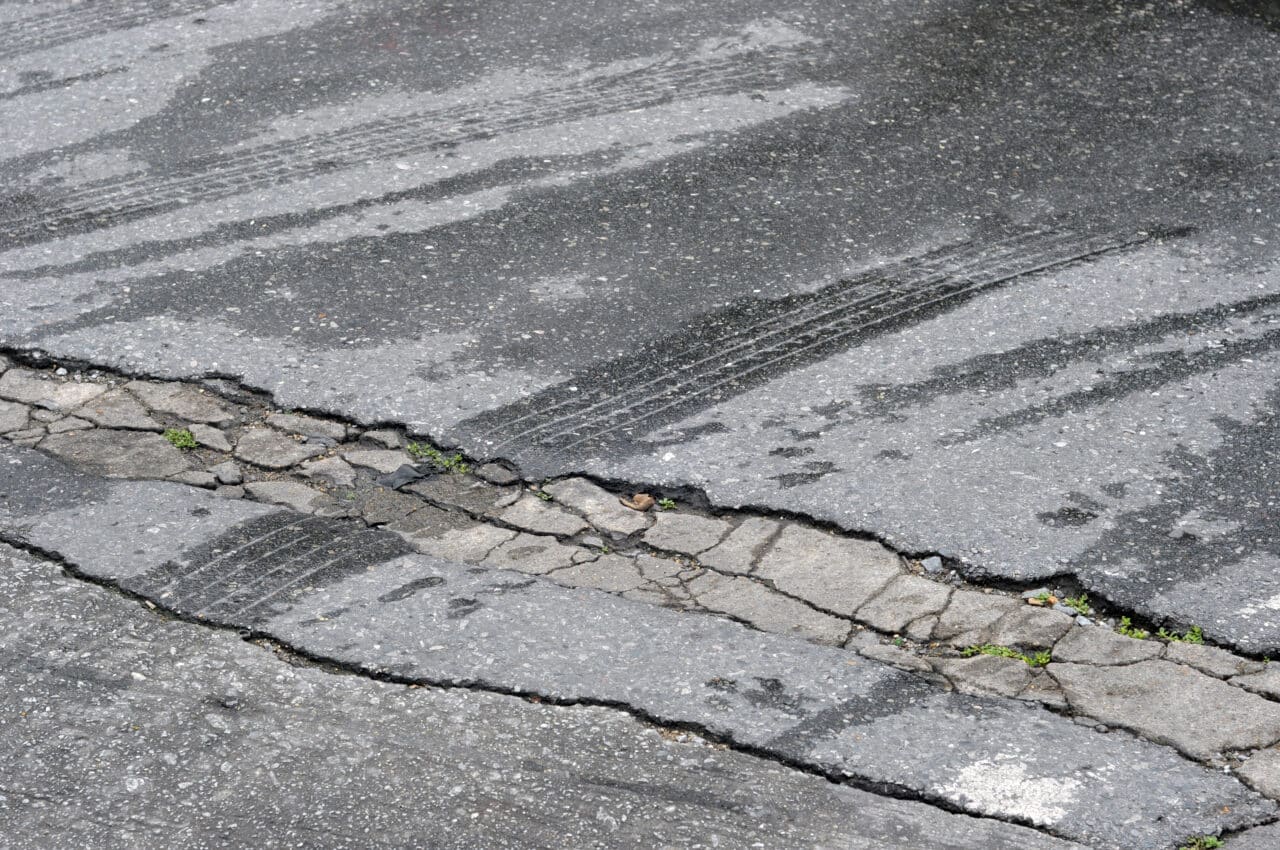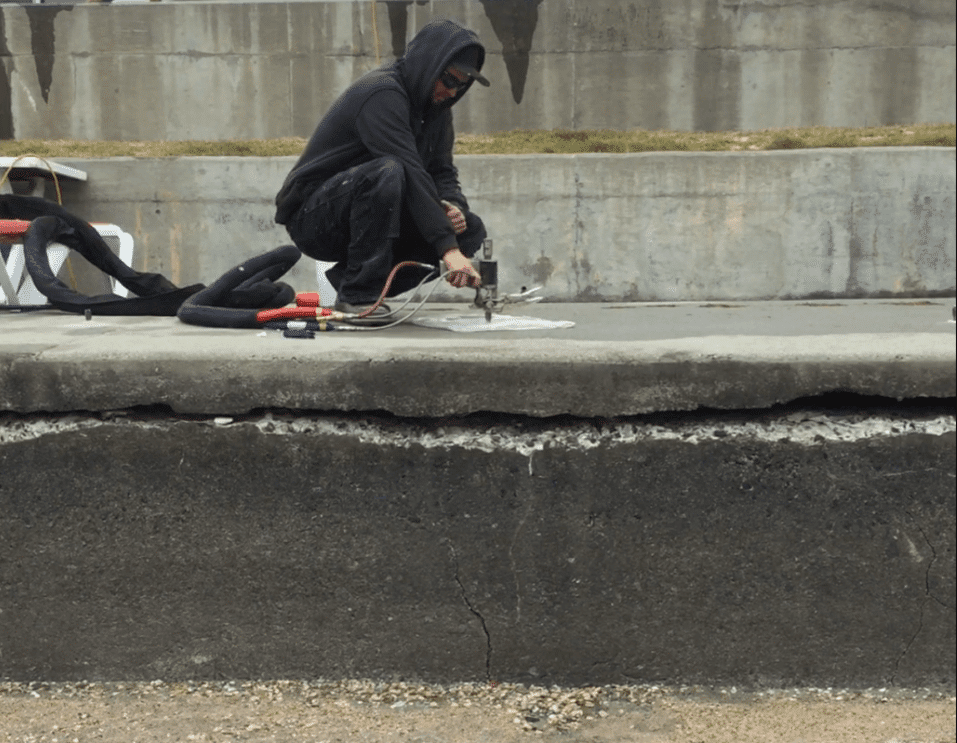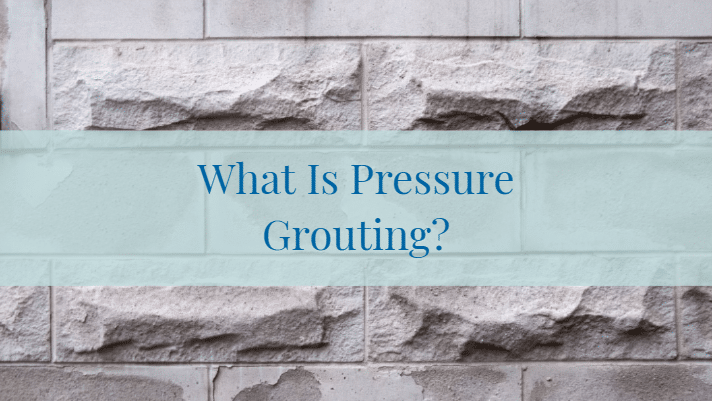Concrete is the most commonly used man-made building material in the world today. Among the qualities that keep it so popular are its strength, fire resistance, insulative properties relative to energy and sound, and its tremendous durability and impact resistance. The earth it’s built on, however, doesn’t share all of these merits. Not all ground is created equal, and much of it lacks the stability for building on. This can often result in significant structural and foundation issues in time. Concrete pressure grouting by a qualified and experienced contractor is one common solution for foundation problems in inaccessible areas.
In this guide, we will cover everything you need to know about pressure grouting, from what it is to how it works and why you may need it. Read on to discover if pressure grouting is the answer for your foundation woes!
What is Pressure Grouting?
Concrete pressure grouting, sometimes called “jet grouting,” is a process in which a contractor injects grout compound into a subterranean void, weakness, or fault that would otherwise require extensive and costly excavation and construction to reach. A number of compounds and mixtures are used for this process, including cement, chemicals, resins, and combinations of these.
Pressure grouting improves the stability of soil and fill by improving the soil’s bearing capacity, reducing settlements, and increasing structural support. This process can be used on various types of soils, including sand and gravel, as well as for the stabilization of foundations in order to prevent sinking or settling. By using pressure grouting, it is possible to strengthen the existing foundation without having to replace it entirely. Pressure grouting is an effective way to reduce settlement problems and improve foundation stability without excessive costs or time-consuming repairs.
Applications of Pressure Grouting
Pressure grouting is a versatile and effective form of soil stabilization that can be used in many applications. One of the most common applications is to reduce settlement issues such as voids, subsidence, and sinkholes. Pressure grouting can also be used to seal and repair cracks in walls and foundations, or to fill large cavities in order to provide extra support for structures.
It is also an excellent way to strengthen soft soils and can be used to enhance drainage systems by reducing water infiltration into the ground. Finally, pressure grouting can also help prevent flooding by raising the ground level around buildings and other structures.

Types of Pressure Grouting
There are different types of concrete pressure grouting available to suit different project needs. These include:
- Cement grouting: This is one of the most common types and involves injecting cement-based grout into the soil, creating a strong bond between particles. This type can be used in areas with low permeability or where there is a risk of erosion or collapse.
- Permeation grouting: This type uses water-soluble materials such as bentonite, polyurethane, or latex, which are injected under pressure to fill voids and create a waterproof seal.
- Compaction grouting: This type involves injecting cement-based grout at high pressure to compact loose soils and reduce settlement issues.
- Jet grouting: This type involves drilling deep into the ground before introducing pressurized water mixed with sand or other materials to strengthen the soil and create solid columns.
Regardless of the type of pressure grouting used, it offers many benefits for all kinds of projects, from small residential foundations to large commercial buildings. It can stabilize the soil, prevent erosion and collapse, and create a strong foundation for the structure.
The Process of Concrete Pressure Grouting
The process of pressure grouting involves injecting a cement-based mixture into the cracks or voids in the concrete under pressure to fill and seal them. Here is a step-by-step guide to the concrete pressure grouting process:
Step 1: Site Preparation
The first step is to prepare the site where the grouting will take place. This involves cleaning the surface of the concrete and removing any loose debris or materials. The site is also inspected to identify the areas that need repair or strengthening.
Step 2: Drilling Holes
The next step is to drill holes into the concrete where the grout will be injected. The size and spacing of the holes will depend on the size and location of the cracks or voids that need to be filled.
Step 3: Inserting Packers
Once the holes are drilled, packers are inserted into them. Packers are small, inflatable tubes that create a seal between the grout and the concrete. The packers are positioned to cover the cracks or voids that need to be filled.
Step 4: Mixing Grout
The grout mixture is then mixed according to the manufacturer’s instructions. The mixture typically includes cement, water, and sometimes additives such as sand, fly ash, or chemicals to improve the flow and strength of the grout.
Step 5: Injecting Grout
The grout is injected into the packers under pressure using a grout pump. The pressure helps to fill and seal the cracks or voids in the concrete. The injection process starts at the lowest point of the repair area and continues until the grout reaches the highest point.
Step 6: Grout Curing
After the grout is injected, it needs time to cure and harden. The curing time will depend on the type of grout used, the temperature, and humidity conditions. The curing process can take several hours to several days.
Step 7: Finishing
Once the grout has cured, the packers are removed, and the holes are filled with a non-shrink grout to match the surrounding concrete surface. The surface is then finished to match the surrounding concrete, and the repair is complete.
Sign You May Need Pressure Grouting
If you suspect that your home or building’s foundation is experiencing problems, it’s important to address the issue as soon as possible to avoid costly repairs down the line. Here are some signs that may indicate the need for pressure grouting services:
- Cracks in the walls or foundation: If you notice cracks in the walls or foundation of your home or building, this could be a sign of foundation settlement or shifting. As the soil settles, it can create voids or gaps in the foundation, which can cause cracks to form.
- Uneven floors: If you notice that your floors are sloping or uneven, this could be a sign of foundation settlement. As the soil settles, it can cause the foundation to shift and become unlevel.
- Doors and windows that don’t close properly: If your doors and windows are difficult to open or close, this could be a sign of the foundation settling or shifting. As the foundation moves, it can cause the frames of the doors and windows to become misaligned.
- Water damage: If you notice water damage or leaks in your basement or crawl space, this could be a sign of foundation problems. As the soil settles, it can create gaps or voids in the foundation that allow water to seep through.
- Cracks in exterior concrete: If you notice cracks in the exterior concrete of your building, such as in walkways or driveways, this could be a sign of soil settlement or shifting.
If you notice any of these signs, it’s important to contact a professional pressure grouting service to assess the situation and determine the best course of action. By addressing foundation problems early on, you can ensure the safety and stability of your home or building for years to come.
Common Causes of Foundation Problems
There are a broad range of causes for failing foundations. Some of the most common are:
Use
Substrata that isn’t ideal for building or that isn’t properly prepared for building can wear, sink, and grow unstable from normal use and pressure and time. Ground that may otherwise sustain building and wear for long periods of time can be compromised more quickly when the structures that straddle it contain building or engineering errors, which are common even with the best credentialed and most experienced builders. Our knowledgeable contractor will be able to assess the causes and potential solutions.
Water penetrates substrata in a number of ways and can cause it to deteriorate. This can be the result of erosion, floods or excessive rain, excessive water accumulation, or improper drainage. Substrata deterioration can be more common and more severe in certain regions of the U.S. If you live in a rainy region, or close to significant bodies of water, have your structures assessed by a grouting contractor regularly.
Substrata Constitution
Substrata constitution is a term used to refer to the natural or man-made formations that exist below the surface of the soil, typically in areas where pressure grouting is being done. This includes the soil composition, types of sediment and rocks, bedrock, groundwater levels, and any other features that may exist below the surface. It can also include other features such as pipelines, sewers, or underground utilities.
Not all earth is inherently suitable for building. And, as it is with the weather, some regions are more vulnerable to faulty substrata than others. A jet grouting contractor in your area will know about potential threats to your foundation.
How Pressure Grouting Solves Foundation Problems
Regardless of the catalyst for foundation problems, it is vital that they be corrected. And one of the least invasive and most cost-effective ways of correcting foundation issues that result from ground faults is pressure grouting by an experienced pressure grouting contractor. Our jet grouting and soil cement stabilization fills, reinforces, and stabilizes faults, sinkholes, and can fill concrete voids under the soil and foundation without jeopardizing the structure or resorting to invasive and costly excavating.
In Need of Concrete Pressure Grouting Services?
Pressure grouting is a common and versatile solution for dangerous foundation problems that can threaten your home but is still a specialized process that requires the training and equipment of a qualified jet grouting contractor. It’s a proven method that can extend the life of your property and prevent costly repairs down the line.
At Slabjack Geotechnical, we have the experience and expertise to deliver top-notch concrete pressure grouting services that meet your specific needs. So don’t wait until it’s too late – Contact one of our grouting contractors today to schedule a consultation and see how we can help protect your property for years to come.

FAQs
What are the benefits of using concrete pressure grouting?
Some of the benefits of using concrete pressure grouting include:
- Enhanced load-bearing capacity: Concrete pressure grouting can increase the bearing capacity of soils by filling voids and compacting the soil particles, making them stronger and more stable. This technique can also be used to stabilize and reinforce weak or loose soil, providing a solid foundation for structures.
- Sealing leaks: Concrete pressure grouting can effectively seal leaks in structures such as dams, tunnels, and buildings, preventing water ingress and avoiding potential structural damage.
- Improved soil and rock formations: Pressure grouting can improve the quality of soil and rock formations by reducing the permeability of soil, increasing the density of the rock, and filling voids and fractures that can affect the stability of a structure.
- Versatility: Concrete pressure grouting is a versatile construction technique that can be used in various applications, such as soil stabilization, foundation repair, structural lifting, and underpinning, among others.
- Cost-effective: Compared to other construction techniques, concrete pressure grouting is often a more cost-effective solution for improving the stability and strength of soils, foundations, and structures.
Is concrete pressure grouting a permanent solution?
Concrete pressure grouting can provide a long-lasting and durable solution for soil stabilization, foundation repair, and other applications. However, its permanence largely depends on the nature of the problem and the conditions of the environment in which it is used.
For instance, if a structure has experienced significant damage or settlement due to soil instability, concrete pressure grouting may be used as a temporary solution while a more permanent fix is planned. On the other hand, if the problem is less severe and the grouting is done correctly, it can be a permanent solution. Additionally, the quality of the materials used, the expertise of the contractor, and the maintenance practices can also affect the longevity of the solution.
Can concrete pressure grouting be used on both new and old structures?
Yes, concrete pressure grouting can be used on both new and old structures. In new structures, pressure grouting is often used during construction to improve soil stability and ensure a solid foundation. For existing structures, pressure grouting can be used to repair or reinforce foundation walls, columns, slabs, and other components that have settled, shifted, or cracked due to soil movement, moisture intrusion, or other factors. The technique can also be used to retrofit existing structures with additional support, such as underpinning or micropiles, to improve their load-bearing capacity.
What maintenance is required for concrete pressure grouting?
Generally, concrete pressure grouting requires minimal maintenance once it has been installed. However, some basic care and upkeep can help ensure the longevity of the solution. The following are some maintenance practices that may be required:
- Regular inspection: Regular inspection of the structure to detect any signs of settlement, cracking, or other issues that may indicate a need for additional grouting.
- Moisture management: Proper moisture management to prevent the buildup of water pressure that can compromise the grouted material.
- Structural integrity: Ensuring the structural integrity of the surrounding components, such as walls, floors, and ceilings, to avoid any undue stress on the grouted material.
- Cleaning: Regular cleaning of the surface of the grouted area to remove any debris or other materials that may interfere with its performance.
- Repair: Prompt repair of any damage or degradation of the grouted material, including cracks or erosion, to prevent further deterioration and maintain its effectiveness.
- Re-grouting: In some cases, re-grouting may be necessary to maintain the stability and structural integrity of the structure. This may be required if the original grouting has been compromised or if the structure has experienced additional settlement or movement.















